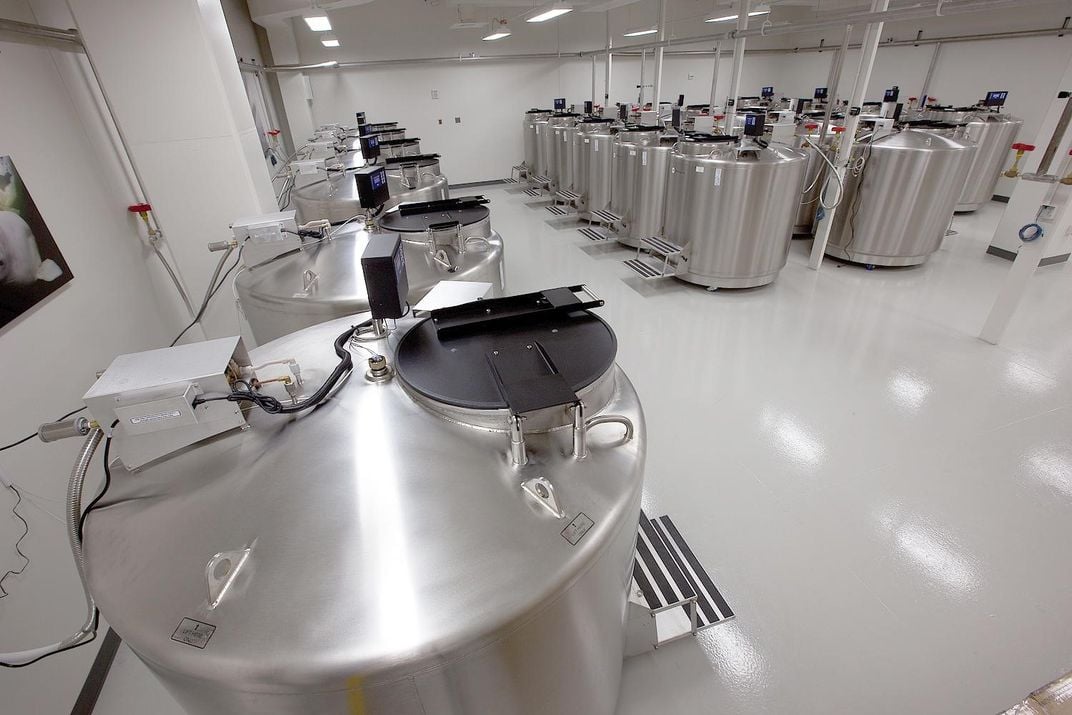NATIONAL MUSEUM OF NATURAL HISTORY
Landmark Study Shares Smithsonian Bird DNA Collected Over Three Decades
A new study in Nature published the genomes — the complete DNA sequences — of 363 species of birds, opening the door for hundreds of new studies.
/https://tf-cmsv2-smithsonianmag-media.s3.amazonaws.com/blogging/featured/People_at_a_counter_topped_with_taxidermied_birds..jpg)
Gary Graves started collecting tissue from birds for the Smithsonian in 1986 — the same year geneticist Thomas H. Roderick coined the term “genomics.” It described the new scientific field of studying all of an organism’s genetic code, or DNA. This code, stored in an organism’s chromosomes, acts like a blueprint. By reading or “sequencing” that blueprint, scientists can learn what makes organisms different from each other.
As a new hire, Graves began freezing and preserving samples of muscle, heart and liver from collected birds in a biorepository — a bank of frozen cells. He had no way of knowing it would eventually become some of the most impactful work of his career.
Today, a study in Nature published the genomes — the complete DNA sequences — of 363 species of birds. 267 of these species had never been sequenced before. The study includes birds from 92% of the 236 avian families. It is part of a larger project called the Bird 10,000 Genomes (B10K) Project, which aims to sequence the genomes of all living bird species within a few years.
This data will open the door for hundreds of new studies. Mapping out the genes of bird species can help scientists figure out how populations evolve, adapt to changes and respond to diseases — vital information for preserving species in decline.
Decades of data put to use
Graves acts as one of seven project organizers from around the world. One of his primary jobs is to help labs working on the project find and acquire tissue samples for extracting DNA. The samples he began collecting 34 years ago came in handy. Scientists across the globe used the National Museum of Natural History’s Avian Genetic Resources Collection — now part of the Global Genome Initiative biorepository — for about 40% of the new bird genomes.

“Where do you start with something like this?” Asked Graves. “Well, you have to start with museums, because museums are the only real biorepositories of genetic material from a diverse array of avian lineages.”
The Smithsonian’s biorepository includes bird species from dozens of expeditions all over the world. That biodiversity made B10K possible. “These are the basic building blocks,” Graves said. “Without this, the project is dead in the water.”
None of the DNA sequenced came from extinct species, but some of the local bird populations that Graves collected tissue from have since disappeared because of human development. As landscapes change, he explained, so do bird populations.
“In a sense, these are little frozen time capsules,” he said. “DNA from a prior age that may never be replicated or revisited.”
Collecting for the future
Originally, Graves preserved tissue for his own research. After a while, however, the collection grew to a size that far surpassed the needs of his research. But Graves and his Smithsonian colleagues continued collecting. He believes one of the most important services Smithsonian scientists provide is giving other researchers access to material that can be difficult to find.

“It’s very gratifying to be able to provide samples and specimens for other people’s use,” he said. He finds it particularly exciting to collect museum specimens with the knowledge that the samples might one day be analyzed by powerful technologies that don’t currently exist.
“Back then, whole genome DNA sequencing had not been invented yet,” Graves chuckled while ruminating on the first tissue samples he froze. “It tells you a little about the enduring value of museum collections: The things that you collect now — you simply can’t envision how they can be used in the future.”
Thousands of species still to study
Graves now considers the Bird 10,000 Genome Project to be the most important endeavor of his career. The B10K project, he explained, has elevated birds to the best-known class of vertebrates on the planet. When asked about why birds made good study subjects, Graves replied that they resonate with human beings. “There are few groups of creatures that are more important — culturally, all over the planet and back into ancient times — than birds,” he said.

In the next phase of the project, researchers will publish genome sequences for thousands of species. Graves expressed hope that the next big publication could be out in less than a year, with more on the way after that. “We’re just getting revved up.”
Related Stories:
Scientists to Read DNA of All Eukaryotes in 10 Years
Meet the Scientist Studying Vulture Guts for Clues to Disease Immunity
How Scientists Still Use the Smithsonian’s First Collections, 170 Years Later
Scientists Describe New Bird Species 10 Years After First Reported Sighting
Are Birds Dinosaurs and Other Questions from Our Readers

